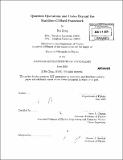| dc.contributor.advisor | Isaac L. Chuang. | en_US |
| dc.contributor.author | Zeng, Bei, Ph. D. Massachusetts Institute of Technology | en_US |
| dc.contributor.other | Massachusetts Institute of Technology. Dept. of Physics. | en_US |
| dc.date.accessioned | 2010-03-25T15:18:52Z | |
| dc.date.available | 2010-03-25T15:18:52Z | |
| dc.date.copyright | 2009 | en_US |
| dc.date.issued | 2009 | en_US |
| dc.identifier.uri | http://hdl.handle.net/1721.1/53235 | |
| dc.description | Thesis (Ph. D.)--Massachusetts Institute of Technology, Dept. of Physics, 2009. | en_US |
| dc.description | Cataloged from PDF version of thesis. | en_US |
| dc.description | Includes bibliographical references (p. 187-196). | en_US |
| dc.description.abstract | The discovery of quantum error-correcting codes (QECCs) and the theory of fault-tolerant quantum computation (FTQC) have greatly improved the long-term prospects for quantum communication and computation technology. Stabilizer codes, a quantum analogue of classical additive codes, are the most important class of QECCs. These codes have dominated the study of quantum error-correction and fault-tolerance ever since the discovery of QECC-FTQC in the mid-1990s. The dominance of stabilizer codes is not only due to their simple construction based on Abelian groups, but also because of the simplicity with which operations in the Clifford group can be performed on them. However, practical QECC-FTQC schemes neither achieve the maximum theoretical communication rate despite the noise nor do they allow sufficient gate failure probability to meet the needs of our current technology. Therefore, it is necessary to go beyond this framework to seek for new QECC-FTQC techniques. This thesis develops a systematic study of QECC-FTQC beyond the Stabilizer-Clifford framework, building on both well-known results and recent theoretical advances. Our new systematic theory includes two main parts. The first part provides further understanding of quantum operations on stabilizer codes, that is, the "minimal subcodes+semi-Clifford operations" theory for studying non-Clifford operations on stabilizer codes. The other part deals with the construction of QECCs, that is, the codeword stabilized (CWS) quantum codes framework combined with the generalized concatenation method for constructing good nonadditive (and stabilizer) quantum codes. | en_US |
| dc.description.abstract | (cont.) Our theory successfully tackles some important open problems in the field (such as a proof of the "transversality versus universality problem for stabilizer codes", and a systematic method for constructing good nonadditive QECCs), and makes progress on many other related open problems (such as the LU-LC equivalence problem for stabilizer codes, and the Ck structure problem). We believe that our theory sheds light on deriving novel QECC-FTQC schemes that will bring us closer to implementing reliable quantum communication systems and building large-scale quantum computers. | en_US |
| dc.description.statementofresponsibility | by Bei Zeng. | en_US |
| dc.format.extent | 196 p. | en_US |
| dc.language.iso | eng | en_US |
| dc.publisher | Massachusetts Institute of Technology | en_US |
| dc.rights | M.I.T. theses are protected by
copyright. They may be viewed from this source for any purpose, but
reproduction or distribution in any format is prohibited without written
permission. See provided URL for inquiries about permission. | en_US |
| dc.rights.uri | http://dspace.mit.edu/handle/1721.1/7582 | en_US |
| dc.subject | Physics. | en_US |
| dc.title | Quantum operations and codes beyond the Stabilizer-Clifford framework | en_US |
| dc.type | Thesis | en_US |
| dc.description.degree | Ph.D. | en_US |
| dc.contributor.department | Massachusetts Institute of Technology. Department of Physics | |
| dc.identifier.oclc | 535632395 | en_US |
